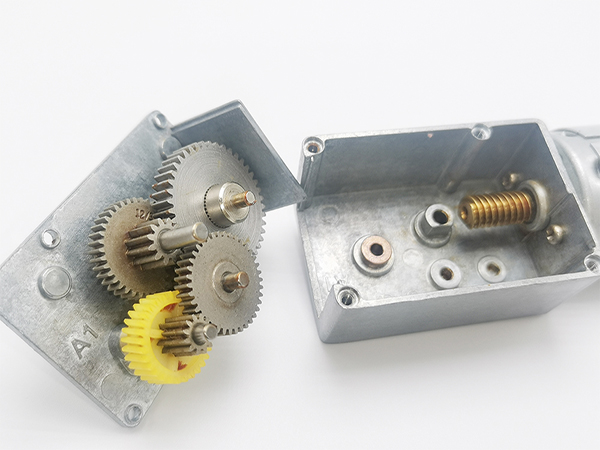What is Worm Gearbox?
What is Worm Gearbox?
A Worm Gearbox of worm gear motor is a fundamental component in motion control systems, highly regarded for its rugged and enduring design. This gearhead consists of an electric DC motor seamlessly integrated with a gearbox, resulting in a potent and reliable assembly.
The core of the Worm Gearbox lies in its core components: the “worm,” a spiral-threaded shaft, and the wheel-shaped “worm wheel.” These vital elements collaborate seamlessly, enabling precise control and highly efficient torque transmission.

Worm Gearboxes stand out due to their remarkable durability and robustness, rendering them exceptionally suitable for rugged and demanding environments. Their ability to withstand harsh conditions and consistently deliver dependable performance sets them apart.
In various industrial and mechanical settings, Worm Gearboxes find extensive use. They offer precise control and are renowned for their ability to handle heavy loads and provide consistent output. This makes them a preferred choice in applications where reliability, robustness, and precise torque transmission are of paramount importance.
Whether in heavy machinery, smart home systems, or any application where durability and dependable performance are vital, the Worm Gearbox plays a pivotal role in ensuring efficient motion control.
How Worm Gearbox Works
A Worm Gearbox is a mechanical marvel renowned for its efficient motion transmission and control. This gearhead relies on a fundamental interaction between two crucial components: the worm screw and the worm wheel.
The worm screw, at the heart of this system, is distinguished by its spiral-threaded shaft, resembling a screw – a key to its unique operation. It meshes seamlessly with the worm wheel, forming a mechanical partnership at a precise 90-degree angle. This connection is pivotal, as it’s the very essence of gear reduction within the Worm Gearbox.

The gear reduction ratio, a critical specification, is determined by the ratio of the number of teeth on the worm wheel to the threads on the worm screw. For instance, with a single-start worm paired with a worm wheel featuring 24 teeth, you achieve a 24:1 gear reduction. This ability to fine-tune gear reduction makes the Worm Gearbox a versatile choice for various applications.
Despite its impressive capabilities, what truly sets the Worm Gearbox apart is its compact design. This feature makes it particularly suitable for scenarios where space constraints are a concern. Moreover, it boasts the exceptional ability to generate substantial rotational force, a characteristic highly valued in applications demanding reliability and power.
The Benefits of Worm Gearbox
Worm gearboxes of worm gear motor bring a wealth of benefits to the table, making them invaluable in various applications. Let’s explore these advantages:

Space Efficiency
Worm gearheads are celebrated for their compact design. This inherent space efficiency is a key asset, particularly in applications where real estate is at a premium. Their ability to deliver substantial power within a confined space is a testament to their engineering excellence.

Reliable Performance
One of the standout features of worm gearboxes is their consistent and reliable performance. They excel in providing precise motion control, ensuring that machinery operates predictably and smoothly. This reliability is a cornerstone of their appeal in critical applications where precision is paramount.

Shock Absorption
Worm gearmotors possess a remarkable ability to absorb energy from sudden shocks and impacts. This quality makes them exceptionally well-suited for heavy equipment and machinery where unexpected jolts can occur. The worm gearbox acts as a shock absorber, safeguarding both the equipment and the safety of operators.

Noise Reduction
In the realm of noise-sensitive applications, worm gearmotors shine. They operate with a hushed demeanor, generating minimal noise during their operation. This low noise profile is particularly advantageous in settings like elevators, where passengers expect a quiet and comfortable ride.

Versatility
Worm gearmotors find utility in a diverse range of applications. They are a common choice in elevators, where space constraints and noise considerations are paramount. Additionally, they prove their mettle in heavy equipment, where their compact size, shock-absorbing capabilities, and quiet operation are highly desirable.
In a Nutshell…
We’ve explored the world of gearheads, delving into the intricacies of planetary, spur, and worm gearheads. Now, let’s summarize the key takeaways to ensure you’ve got a clear understanding of these essential components in mechanical systems.
Gearheads play indispensable roles in mechanical systems, and understanding the differences between planetary, spur, and worm gearheads is pivotal for optimizing your applications. Each type offers unique advantages and disadvantages, making the choice of gearhead crucial to your project’s success.
Spur gearheads, with their simplicity and cost-effectiveness, are ideal for low-torque, low-RPM tasks but may not suit high-precision applications due to drawbacks like backlash and efficiency concerns.
Planetary gearheads shine in high-torque, high-RPM scenarios. They provide precise and efficient motion control, thanks to their design. However, they come at a higher cost and require more maintenance.
Worm gearboxes are champions of high reduction ratios and self-locking capabilities, making them perfect for confined, noise-sensitive applications. Still, their efficiency may not suffice for high-speed tasks.
Choosing the right gearhead depends on your specific needs. Consider factors like torque requirements, speed, available space, and noise constraints. High-speed, high-torque applications may benefit from planetary gearheads, while cost-effective, low-torque needs align with spur gearheads. In noise-sensitive, confined spaces, worm gearboxes are the top choice.
Ultimately, your gearhead selection impacts your project’s efficiency, reliability, and success. Whether you’re designing robots, industrial machinery, or precision equipment, make the right choice to ensure your mechanical systems operate optimally and meet your project’s demands.
